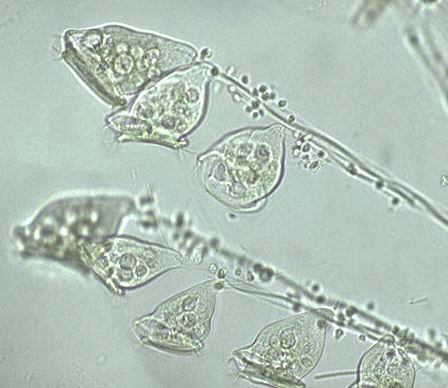

Oligohymenophorea:
Peritrichia: Sessilida: Vorticellidae
Carchesium polypinum
Linnaeus, 1758
 Genus: Colonial; each zooid has a separately contractile myoneme
(Illustrated Guide, 1985).
Each animal has its own myoneme, can contract singly without causing colony to contract (How to know the
protozoa, 1979).
Genus: Colonial; each zooid has a separately contractile myoneme
(Illustrated Guide, 1985).
Each animal has its own myoneme, can contract singly without causing colony to contract (How to know the
protozoa, 1979).
Species:
100-125 μm long;
colony up to 3 mm; fresh water (Kudo, 1966).
120-125 μm long
(How to know the protozoa, 1979).
Body bell-shaped; 80-140 μm long;
a macronucleus C-shaped (Kojima, et al., 1995).
|
Similar Genus ->>
Zoothamnium;
Vorticella;
Opercularia;
Epistylis;
Carchesium polypinum,
cell body 100 μm long, μm wide, ach zooid has a separate myoneme,
with Diploeca, Choanoflagellida,
x 100, x 200, x 400, Japan, 1997 by Y. Tsukii
 100 μm
100 μm
 200 μm
200 μm
 300 μm; x 200 :
300 μm; x 200 :
 50 μm
50 μm
 100 μm
100 μm
 150 μm; x 400
150 μm; x 400




Carchesium polypinum Linnaeus, 1758:
100-125 μm long;
colony up to 3 mm; fresh water (Kudo, 1966).
120-125 μm long
(How to know the protozoa, 1979).
Body bell-shaped; 80-140 μm long;
a macronucleus C-shaped (Kojima, et al., 1995).
Carchesium granulatum Kellicott:
About 100 μm long;
two contractile vacuoles anterior (Kudo, 1966).
cf.
Zoothamnium: Like Carchesium but myonemes of individuals are connected as a single, branched
contractile system, whole colony contracts at once (How to know the protozoa, 1979).
Please click on images for viewing enlarged.
Copyright
Protist Information Server
 Genus: Colonial; each zooid has a separately contractile myoneme
(Illustrated Guide, 1985).
Each animal has its own myoneme, can contract singly without causing colony to contract (How to know the
protozoa, 1979).
Genus: Colonial; each zooid has a separately contractile myoneme
(Illustrated Guide, 1985).
Each animal has its own myoneme, can contract singly without causing colony to contract (How to know the
protozoa, 1979).



